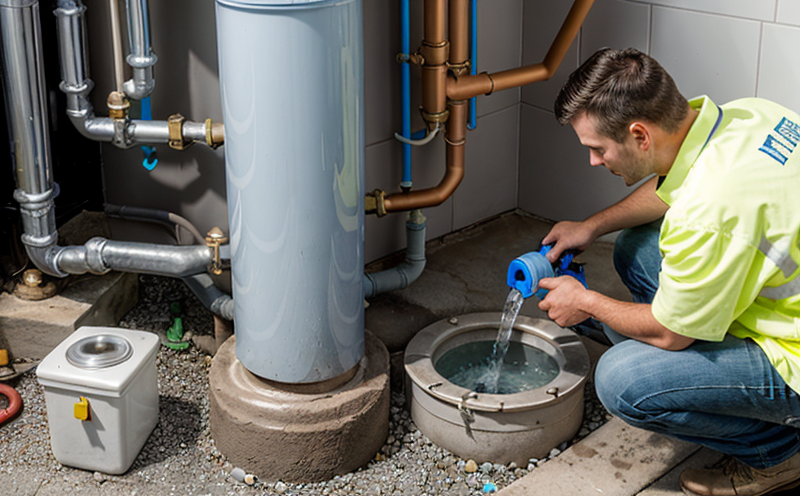ASTM D3261 Joining of Thermoplastic Pipes
The ASTM D3261 standard specifies the procedures and conditions required to join thermoplastic pipes using fusion welding. This method is widely used in building and infrastructure projects where durability, leak resistance, and long-term performance are critical. Thermoplastics such as polyethylene (PE) or polyvinyl chloride (PVC) are chosen for their ease of processing, low weight, and excellent chemical and mechanical properties.
The ASTM D3261 standard provides detailed procedures to ensure that the fusion welds meet specific criteria, including tensile strength, elongation at yield, and visual inspection. These tests help guarantee that the pipe joints are strong enough to withstand the pressures and stresses they will encounter during installation and operation.
Quality managers in building and infrastructure projects often rely on ASTM D3261 to ensure compliance with industry standards and to maintain the integrity of their work. This standard is essential for ensuring that thermoplastic pipes are joined correctly, which can help prevent leaks, failures, and costly repairs down the line.
The fusion welding process involves heating the ends of the pipes until they reach a specific temperature range where the thermoplastics become soft but not molten. The heated sections are then brought into contact with each other to form a single continuous piece. Once joined, the joint is cooled and tested for integrity.
Compliance officers will find ASTM D3261 particularly useful when auditing projects that involve thermoplastic piping systems. R&D engineers can use this standard to develop new joining methods or improve existing ones. Procurement teams may also benefit by ensuring that suppliers adhere to the same rigorous standards, enhancing the quality and reliability of their products.
For effective fusion welding, it is crucial to follow ASTM D3261 closely. This includes selecting appropriate equipment, controlling temperature, ensuring proper alignment of pipes, and conducting thorough inspections post-welding. Proper adherence ensures that the final product meets the specified performance criteria and provides long-term serviceability.
The ASTM D3261 standard is widely used in various sectors where thermoplastic piping systems are installed, including residential buildings, commercial structures, industrial facilities, and public infrastructure projects. Its application extends to applications such as water supply lines, drainage systems, and chemical transport pipelines.
Benefits
Adhering to ASTM D3261 offers several key benefits:
- Enhanced Durability: Properly executed fusion welding ensures that the pipes can withstand the pressures and stresses they will encounter during operation.
- Leak Resistance: The standard helps prevent leaks by ensuring that joints are strong and watertight.
- Long-Term Performance: ASTM D3261 guarantees that thermoplastic pipes will perform reliably over the long term, reducing the need for costly repairs or replacements.
- Compliance with Industry Standards: Following this standard ensures compliance with international regulations and industry best practices.
Incorporating ASTM D3261 into your project management processes can lead to significant cost savings by minimizing the risk of failures, leaks, or other issues that could arise from improperly executed fusion welding. It also enhances reputation through adherence to recognized standards.
International Acceptance and Recognition
The ASTM D3261 standard is widely accepted in numerous countries around the world, including the United States, Canada, Europe, Australia, and Asia. Countries like Germany (DIN), France (NF), and Japan have their own standards that are aligned with ASTM D3261 or provide similar guidelines for thermoplastic pipe joining.
- Australia: AS/NZS 9480:2017 specifies welding procedures for PE pipes, which aligns closely with ASTM D3261.
- United Kingdom: BS EN ISO 15593-1 is a European standard that covers the fusion-welding of thermoplastics and includes procedures similar to ASTM D3261.
- Canada: CSA B68.7-M04 provides specific requirements for PE pipes, which are consistent with ASTM D3261.
- India: IS 1599:2015 also includes procedures that match the ASTM standard in many respects.
The acceptance and recognition of ASTM D3261 demonstrate its importance in ensuring quality and reliability across international markets. It is a testament to the standard's rigorous testing methods and adherence to global best practices in thermoplastic pipe joining.
Use Cases and Application Examples
| Use Case | Description |
|---|---|
| Water Supply Systems: | Fusion welding is used to join pipes in residential, commercial, and industrial water supply systems. |
| Sanitary Sewage Systems: | The standard ensures that drainage systems are leak-proof and capable of withstanding the pressures encountered during operation. |
| Chemical Transport Pipelines: | Fusion welding is critical for transporting hazardous chemicals safely in industrial settings. |
| Underground Utilities: | The standard helps ensure that underground utility lines are joined securely, reducing the risk of leaks or failures. |
| Hazardous Waste Transport: | Fusion welding is used to join pipes for transporting hazardous waste in a safe and secure manner. |
These use cases highlight the versatility and importance of ASTM D3261 in various sectors. By ensuring that thermoplastic pipe joints meet the specified criteria, this standard helps protect public health and safety while minimizing environmental impacts.





